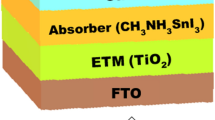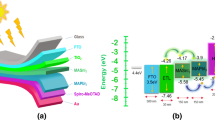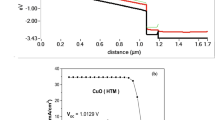Abstract
Organic–inorganic halide perovskite solar cells (PSCs) have received extensive research in the field of optoelectronic materials. The absorption layer widely used in PSCs is methylammonium lead trihalide (MAPbX3, X = Cl, Br, I), still, the toxicity of lead (Pb) restricts its development, tin-based perovskite MASnI3 has attracted much attention due to its sound absorption characteristics. In this work, the perovskite solar cell adopts an inverted HTL-free structure, and the one-dimensional solar cell capacitor simulator SCAPS-1D (Solar Cell Capacitance Simulator) was adopted for numerical simulation and found that FTO/CH3NH3SnI3/C60/Au structure PSCs also showed excellent photovoltaic performance. We studied the influence of the thickness of the absorber layer, the defect density, the doping concentration of different layers, and we also studied PSCs with two structures, upright (p-i-n) and inverted (n-i-p) under the same lighting conditions. The simulation results show that the optimized inverted HTL-free tin-based PSCs based on C60 is with inspiring performance: a short-circuit current density (JSC) of 32.4566 mA/cm2, Open circuit voltage VOC (V) of 0.8585 V, fill factor (FF) of 73.72% and power conversion efficiency (PCE) of 20.54%. Based on HTL-free, the inverted structure can realize the PSCs to the maximum extent to ensure the light intensity of the incident perovskite layer, and the light-induced carriers could be effectively collected, directly increase the number of excitable electron–hole pairs, showing better performance. Based on the inverted HTL-free tin-based PSCs, we also listed the PSCs performance parameters of different material ETL. This work provides new ideas for PSCs development in the future.









Similar content being viewed by others
References
Abdelaziz, S., Zekry, A., Shaker, A., Abouelatta, M.: Investigating the performance of formamidinium tin-based perovskite solar cell by scaps device simulation. Optical Materials. 101, 109738.1–109738.8 (2020)
Akhiro, K., Kenjiro, T., Yasuo, S., Tsutomu, M.: Organometal halide perovskites as visible-light sensitizers for photovoltaic cells. J. Am. Chem. Soc. 131, 6050–6051 (2009)
Anwar, F., Mahbub, R., Satter, S.S., Ullah, S.M.: Effect of different HTM layers and electrical parameters on ZnO nanorod-based lead- free perovskite solar cell for high-efficiency performance. Int. J. Photoenergy. 2017, 1–9 (2017)
Azri, F., Meftah, A., Sengouga, N., Meftah, A.: Electron and hole transport layers optimization by numerical simulation of a perovskite solar cell. Sol. Energy 181, 372–378 (2019)
Bao, X., Zhu, Q., Qiu, M., Yang, A., Wang, Y., Zhu, D., Wang, J., Yang, R.: High-performance inverted planar perovskite solar cells without hole transport layer via solution process under ambient condition. J. Mater. Chem. 3, 19294–19298 (2015)
Burgelman, M., Nollet, P., Degrave, S.: Modelling polycrystalline semiconductor solar cells. Thin Solid Films 361–362, 527–532 (2000)
Cai, M., Wu, Y., Chen, H., Yang, X., Qiang, Y.: Cost-performance analysis of perovskite solar modules. Advanced Science. 4, 1600269 (2017)
Chen, H., Yang, S.: Stabilizing and scaling up carbon-based perovskite solar cells. Adv. Mater. 32, 3011–3020 (2017)
Chen, H., Yang, S.: Methods and strategies for achieving high-performance carbon-based perovskite solar cells without hole transport materials. J. Mater. Chem. A. 7, 15476–15490 (2019)
Chen, Z., Yu, C., Kai, S., Wang, J.J., Vockic, N., Midgley, J., Kenney, J.T.: Photoluminescence study of polycrystalline CsSnI3 thin films: Determination of exciton binding energy. J. Lumin. 132, 345–349 (2012)
Chung, I., Lee, B., He, J., Chang, R.P.H., Kanatzidis, M.G.: All-solid-state dye-sensitized solar cells with high efficiency. Nature 485, 486–489 (2012)
Du, H.J., Wang, W.C., Zhu, J.: Device simulation of lead-free CH3NH3SnI3 perovskite solar cells with high efficiency. Chin. Phys. 25, 108802 (2016)
Frost, Jarvist, M., Butler, Keith, T., Brivio, Federico, Hendon, Christopher.: atomistic origins of high-performance in hybrid halideperovskite solar cells. Nano Letters. 14, 2584–2590(2014)
Gratzel M, M.: The light and shade of perovskite solar cells. Nature Materials. 13, 838-842 (2014)
Hao, F., Stoumpos, C.C., Cao, D.H., Chang, R.P.H., Kanatzidis, M.G.: Lead-Free Solid-State Organic-Inorganic Halide Perovskite Solar Cells. Nat. Photonics 8, 489–494 (2014a)
Hao, F., Stoumpos, C.C., Chang, R.P.H., Kanatzidis, M.G.: Anomalous band gap behavior in mixed Sn and Pb perovskites enables broadening of absorption spectrum in solar cells. J. Am. Chem. Soc. 136, 8094–8099 (2014b)
Hd, A., Dp, B., Skp, B.: Improvement in performance of lead free inverted perovskite solar cell by optimization of solar parameters. Optik 179, 969–976 (2019)
Hu, H., Wang, D., Zhou, Y., Zhang, J., Lv, S., Pang, S., Chen, X., Liu, Z., Padture, N.P., Cui, G.: Vapour-based processing of hole-conductor-free CH3NH3PbI3 perovskite/C60 fullerene planar solar cells. RSC Adv. 4, 28964–28967 (2014)
Huang, L., Sun, X., Chang, L., Rui, X., Zhang, J.: Electron transport layer-free planar perovskite solar cells: further performance enhancement perspective from device simulation. Sol. Energy Mater. Sol. Cells 157, 1038–1047 (2016)
Jokar, E., Chien, C.H., Fathi, A., Rameez, M., Chang, Y.H., Diau, E.: Slow surface passivation and crystal relaxation with additives to improve device performance and durability for tin-based perovskite solar cells. Energy Environ. Sci. 11, 2353–2362 (2018)
Ke, C., Wu, P., Yang, W., Su, R., Luo, D., Yang, X., Tu, Y., Zhu, R., Gong, Q.: Low-dimensional perovskite interlayer for highly efficient lead-free formamidinium tin iodide perovskite solar cells. Nano Energy 49, 411–418 (2018)
Kim, H.S., Lee, C.R., Im, J.H., Lee, K.B., Moehl, T., Marchioro, A., Moon, S.J., Huhphry-Brker, R., Yum, J.H., Moser, J.E., Gratazel, M., Park, N.G.: Lead iodide perovskite sensitized all-solid-state submicron thin film mesoscopic solar cell with efficiency exceeding 9%. Sci. Rep. 2, 1–7 (2012a)
Kim, H.S., Lee, C.R., Im, J.H., Lee, K.B., Moehl, T., Marchioro, A., Moon, S.J., Humphry-Baker, R., Yum, J.H., Moser, J.E., Grätzel, M., Park, N.G.: Lead iodide perovskite sensitized all-solid-state submicron thin film mesoscopic solar cell with efficiency exceeding 9%. Sci. Rep. 2, 591 (2012b)
Kulkarni, S.A., Baikie, T., Boix, P.P., Yantara, N., Mathews, N., Mhaisalkar, S.: Band-gap tuning of lead halide perovskites using a sequential deposition process. Journal of Materials Chemistry A. 2, 9221–9225 (2014)
Laban, W.A., Etgar, L.: Depleted hole conductor-free lead halide iodide heterojunction solar cells. Energy Environ. Sci. 6, 3249–3253 (2013)
Lakhdar, N., Hima, A.: Electron transport material effect on performance of perovskite solar cells based on CH3NH3GeI3. Optical Mater. 99, 109517 (2019)
Lakhdar, N., Hima, A.: Electron transport material effect on performance of perovskite solar cells based on CH3NH3GeI3. 99, 109517 (2020)
Li, W., Dong, H., Wang, L., Li, N., Guo, X., Li, J., Qiu, Y.: Montmorillonite as bifunctional buffer layer material for hybrid perovskite solar cells with protection from corrosion and retarding recombination. Mater, J. Chem. A. 2, 13587–13592 (2014)
Liao, W., Zhao, D., Yu, Y., Corey, R.G., Wang, C., Alexander, J.: Lead-Free Inverted Planar Formamidinium Tin Triiodide Perovskite Solar Cells Achieving Power Conversion Efficiencies up to 6.22%. Adv. Mater. 28, 9333–9340 (2016)
Lin, L., Jiang, L., Qiu, Y., Fan, B.: Analysis of Sb2Se3/Cds based photovoltaic cell: a numerical simulation approach. J. Phys. Chem. Solids 122, 199–224 (2018)
Lin, S.Y., Su, T.S., Hsieh, T.Y., Lo, T.C., Wei, T.C.: Efficient plastic perovskite solar cell with a low-temperature processable electrodeposited TiO2 compact layer and a brookite TiO2 scaffold. Adv. Energy Mater. 7, 1700169.1–1700169.9 (2017)
Liu, J., Wu, Y., Qin, C., Yang, X., Yasuda, T., Islam, A., Zhang, K., Peng, W., Chen, W., Han, L.: A dopant-free hole-transporting material for efficient and stable perovskite solar cells. Energy Environ. Sci. 7, 2963–2967 (2014)
Maniarasu, S., Korukonda, T.B., Manjunath, V., Ramasamy, E., Ramesh, M., Veerappan, G.: Recent advancement in metal cathode and hole-conductor-free perovskite solar cells for low-cost and high stability: A route towards commercialization. Renewable Sustainable Energy Rev. 82, 845–857 (2018)
Manish, K., Raj, A., Kumar, A., Anshul, A.: An optimized lead-free formamidinium Sn-based perovskite solar cell design for high power conversion efficiency by SCAPS simulation. 108,110213 (2020)
Marshall, K.P., Walker, M., Walton, R.I., Hatton, R.A.: Enhanced stability and efficiency in hole-transport-layer-free CsSnI3 perovskite photovoltaics. Nat. Energy 1, 16178 (2016)
Mei, A., Li, X., Liu, L., Ku, Z., Liu, T., Rong, Y., Xu, M., Hu, M., Chen, J., Yang, Y., Grätzel, M., Han, H.: A hole-conductor-free, fully printable mesoscopic perovskite solar cell with high stability. Science 345, 295–297 (2014)
Minemoto, T., Murata, M.: Impact of work function of back contact of perovskite solar cells without hole transport material analyzed by device simulation. Curr. Appl. Phys. 14, 1428–1433 (2014)
Noh, J.H., Im, S.H., Heo, J.H.: Chemical management for colorful, efficient, and stable inorganic-organic hybrid nanostructured solar cells. Nano Lett. 13, 1764–1769 (2013)
Rai, S., Pandey, B.K., Dwivedi, D.K.: Modeling of highly efficient and low cost CH3NH3Pb(I1-xClx)3 based perovskite solar cell by numerical simulation. Opt. Mater. 100, 109631 (2020)
Roy, P., Sinha, N.K., Khare, A.: An investigation on the impact of temperature variation over the performance of tin-based perovskite solar cell: a numerical simulation approach. Materialstoday: Proceedings. 39, 2022–2026 (2020)
Shockley, W., Queisser, H.J.: Detailed balance limit of efficiency of p-n junction solar cells. J. Appl. Phys. 32, 510–519 (1961)
Stranks, S.D., Eperon, G.E., Grancini, G., Menelaou, C., Alcocer, M.J.P., Leijtens, T., Herz, L.M., Petrozza, A., Snaith, H.J.: Electron-hole diffusion lengths exceeding 1 micrometer in an organometal trihalide perovskite absorber. Science 342, 341–343 (2013)
Wu, W.Q., Wang, Q., Fang, Y., Shao, Y., Tang, S., Deng, Y., Lu, H., Liu, Y., Li, T., Yang, Z., Gruverman, A., Huang, J.: Molecular doping enabled scalable blading of efficient hole-transport-layer-free perovskite solar cells. Nat. Commun. 9, 1625 (2018)
Xie, F., Zhou, S., Zhao, N., Hui, H.: Native defect-induced hysteresis behavior in organolead iodide perovskite solar cells. Adv. Func. Mater. 26, 1411–1419 (2016)
Xing, G., Mathews, N., Sun, S., Lim, S.S., Lam, Y.M., Gratzel, M., Mhaisalkar, S., Sum, T.C.: Long-range balanced electron and hole-transport lengths in organic-inorganic CH3NH3PbI3. Science 342, 3443–3447 (2013b)
Xing, G., Mathews, N., Sun, S., Lim, S.S., Sum, T.C.: Long-range balanced electron-and hole-transport lengths in organic-inorganic CH3NH3PbI3. Science 342, 344–347 (2013a)
Yu, C., Chen, Z., Wang, J.J., Pfenninger, W., Vockic, N., Kenney, J.T., Shum, K.: Temperature dependence of the band gap of perovskite semiconductor compound CsSnI3. J. Appl. Phys. 110, 063526 (2011)
Zhu, Z., Chueh, C.C., Li, N., Mao, C., Jen, K.Y.: Realizing Efficient Lead-Free Formamidinium Tin Triiodide Perovskite Solar Cells via a Sequential Deposition Route. Adv. Mater. 30, 1703800.1–1703800.9 (2018)
Author information
Authors and Affiliations
Contributions
LH Collected the data, Contributed data or analysis tools, Performed the analysis, Performed the computer simulations, Wrote the paper. TL Conceived and designed theanalysis, Contributed data or analysis tools, Wrote the paper. XM Conceived and designed theanalysis, Contributed data or analysis tools, Wrote the paper. JW Conceived and designed the analysis, Contributed data or analysis tools, Wrote the paper. LQ Conceived and designed the analysis, Contributed data or analysis tools, Wrote the paper. XW Conceived and designed the analysis, Contributed data or analysis tools, Wrote the paper. GH Conceived and designed the analysis, Contributed data or analysis tools, Wrote the paper. HP Conceivedand designed the analysis, Contributed data or analysis tools, Wrote the paper. XW Conceived and designed the analysis, Contributed data or analysis tools, Wrote the paper. XZ Conceived and designed the analysis, Contributed data or analysis tools, Wrote the paper.
Corresponding author
Ethics declarations
Conflict of interest
The authors declare that they have no conflict of interest.
Additional information
Publisher's Note
Springer Nature remains neutral with regard to jurisdictional claims in published maps and institutional affiliations.
Rights and permissions
About this article
Cite this article
Hao, L., Li, T., Ma, X. et al. A tin-based perovskite solar cell with an inverted hole-free transport layer to achieve high energy conversion efficiency by SCAPS device simulation. Opt Quant Electron 53, 524 (2021). https://doi.org/10.1007/s11082-021-03175-5
Received:
Accepted:
Published:
DOI: https://doi.org/10.1007/s11082-021-03175-5




